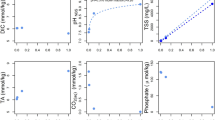Abstract
We present the mass balances associated with carbon dioxide (CO2) removal (CDR) using seawater as both the source of reactants, and as the reaction medium via electrolysis following the “Equatic™” (formerly known as “SeaChange”) process (La Plante et al. in ACS EST Eng. https://doi.org/10.1021/acsestengg.3c00004, 2023). This process, extensively detailed in La Plante et al. (Chem Eng. https://doi.org/10.1021/acssuschemeng.0c08561, 2021), involves the application of an electric overpotential that splits water to form H+ and OH– ions, producing acidity and alkalinity, i.e., in addition to gaseous co-products, at the anode and cathode, respectively. The alkalinity that results, i.e., via the “continuous electrolytic pH pump” results in the instantaneous precipitation of calcium carbonate (CaCO3), hydrated magnesium carbonates (e.g., nesquehonite: MgCO3·3H2O, hydromagnesite: Mg5(CO3)4(OH)2·4H2O, etc.), and/or magnesium hydroxide (Mg(OH)2) depending on the CO32– ion-activity in solution. This results in the trap**, and hence durable and permanent (at least ~ 10,000–100,000 years) immobilization of CO2 that was originally dissolved in water, and that is additionally drawn down from the atmosphere within: (a) mineral carbonates, and/or (b) as solvated bicarbonate (HCO3–) and carbonate (CO32–) ions (i.e., due to the absorption of atmospheric CO2 into seawater having enhanced alkalinity). Taken together, these actions result in the net removal of ≈ 4.6 kg of CO2 per m3 of seawater catholyte processed. Overall, this analysis provides direct quantifications of the ability of the Equatic™ process to serve as a means for technological CDR to mitigate the worst effects of accelerating climate change.
Access this chapter
Tax calculation will be finalised at checkout
Purchases are for personal use only
Similar content being viewed by others
References
La Plante EC, Chen X, Bustillos S, Bouissonnie A, Traynor T, Jassby D, Corsini L, Simonetti DA, Sant GN (2023) Electrolytic seawater mineralization and the mass balances that demonstrate carbon dioxide removal. ACS EST Eng. https://doi.org/10.1021/acsestengg.3c00004
La Plante EC, Simonetti DA, Wang J, Al-Turki A, Chen X, Jassby D, Sant GN (2021) Saline water-based mineralization pathway for gigatonne-scale CO2 management. ACS Sustain Chem Eng 9(3):1073–1089. https://doi.org/10.1021/acssuschemeng.0c08561
Intergovernmental Science-Policy Platform on Biodiversity and Ecosystem Services (2022) Summary for policymakers of the methodological assessment of the diverse values and valuation of nature of the Intergovernmental Science-Policy Platform on Biodiversity and Ecosystem Services (IPBES). Zenodo, Bonn. https://doi.org/10.5281/zenodo.7410287
Parkhurst DL, Appelo CAJ (2013) Description of input and examples for PHREEQC Version 3—a computer program for speciation, batch-reaction, one-dimensional transport, and inverse geochemical calculations. US Geol Surv Tech Methods Book 6:497
Millero FJ, Feistel R, Wright DG, McDougall TJ (2008) The composition of standard seawater and the definition of the reference-composition salinity scale. Deep Sea Res Part Oceanogr Res Pap 55(1):50–72. https://doi.org/10.1016/j.dsr.2007.10.001
NOAA US Department of Commerce. Global Monitoring Laboratory—carbon cycle greenhouse gases. https://gml.noaa.gov/ccgg/trends/mlo.html. Accessed 08 Sept 2021
Chay F, Klitzke J, Hausfather Z, Martin K, Freeman J, Cullenward D (2022) Verification confidence levels for carbon dioxide removal. CarbonPlan. https://carbonplan.org/research/cdr-verification-explainer
Doney SC, Busch DS, Cooley SR, Kroeker KJ (2020) The impacts of ocean acidification on marine ecosystems and reliant human communities. Annu Rev Environ Resour 45(1)
Kroeker KJ, Kordas RL, Crim R, Hendriks IE, Ramajo L, Singh GS, Duarte CM, Gattuso J-P (2013) Impacts of ocean acidification on marine organisms: quantifying sensitivities and interaction with warming. Glob Change Biol 19(6):1884–1896. https://doi.org/10.1111/gcb.12179
Author information
Authors and Affiliations
Corresponding authors
Editor information
Editors and Affiliations
Rights and permissions
Copyright information
© 2024 The Minerals, Metals & Materials Society
About this paper
Cite this paper
La Plante, E.C., Simonetti, D.A., Jassby, D., Corsini, L., Sant, G.N. (2024). Seawater Enables High-Quality Carbon Removal. In: Iloeje, C., et al. Energy Technology 2024. TMS 2024. The Minerals, Metals & Materials Series. Springer, Cham. https://doi.org/10.1007/978-3-031-50244-6_9
Download citation
DOI: https://doi.org/10.1007/978-3-031-50244-6_9
Published:
Publisher Name: Springer, Cham
Print ISBN: 978-3-031-50243-9
Online ISBN: 978-3-031-50244-6
eBook Packages: Chemistry and Materials ScienceChemistry and Material Science (R0)




